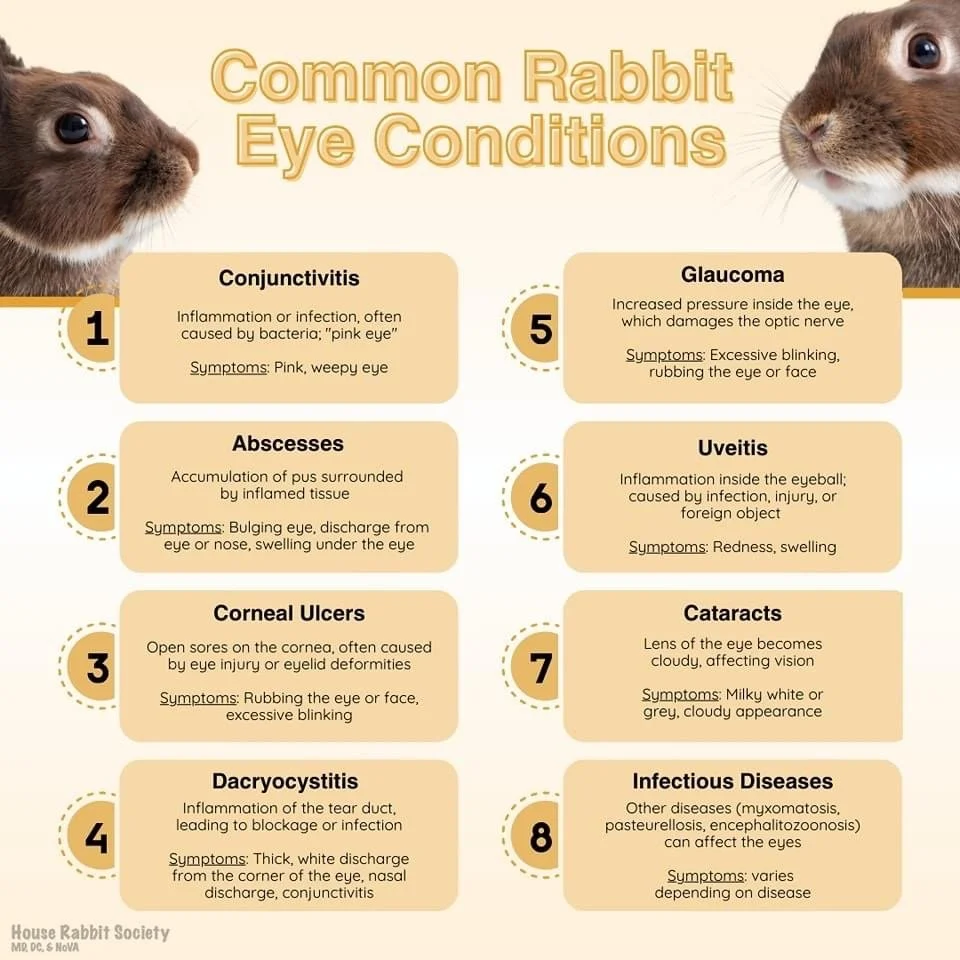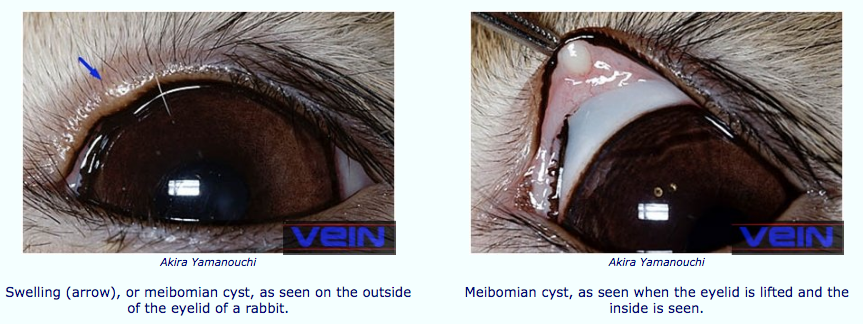Eyes
Weeping, runny, cloudy, red or bulging eyes, discharge of thin white strings of mucus, pus, wet cheeks, pawing at the eye and squinting are all signals that your rabbit needs to visit the vet. Eye issues are not something that a rabbit owner can diagnose and treat at home and can progress rapidly. Any eye abnormality should be assessed by a vet within 24 hours - ALWAYS consult your vet sooner rather than later. Don’t wait to see if the problem will self resolve
"The fascination of comparative ophthalmology lies in the amazing similarity between the eyes of very divergent species. Yet there are small but significant anatomical, physiological and pathobiological differences between the familiar eyes of the dog and cat and those of the rabbit, guinea pig, mouse and rat which have substantial implications for the treatment of ophthalmic conditions in these animals. Here we seek to outline the differences between rodents and lagomorphs and the more commonly seen dog and cat and discuss the effects these differences have on diagnosis and treatment of ocular disease in these small mammal species."
Rabbit and Rodent Ophthalmology
Common Eye Issues
Diseases of the Eye in Rabbits
Runny eyes
Differential diagnosis for a runny eye in rabbits
Viral and Bacterial Conjunctivitis
The symptoms of eye infections in rabbits present as a milky white discharge from the corner of the eye. The infection may result in sore reddened skin just below the lower eyelid of the rabbit's eye. Any suspected eye infection needs to be diagnosed by a veterinarian. Bacterial eye infections in rabbits can become serious very quickly and immediate treatment is needed to avoid complications.
Treatment - which consist of antibiotics drops as well as oral antibiotics and painkillers will work well if the conjunctivitis is caused by an infection. However it is common for conjunctivitis in rabbits to be secondary to other illnesses such as dental disease. Should the condition not improve quickly, further investigation will be necessary to find out what the underlying cause of the problem is.
Nestbox Eye in Kits
"Around 10-12 days, eyelids of newborn rabbits separate and the young can finally discover their environment. It happens, however, that eyelids remain shut. Causes and how to fix this problem?"
Nestbox Eyelid in Kits
Blocked Tear Ducts
The Tear duct is a passage for tears between the eye and the nose and the eyes may water due to an obstruction. There may be a physical obstruction due to bony obstructions - including dental issues, (see below) or misshapen eyelids can also affect where the tears go. Physical obstruction can also include Neoplasias (cancers) in the sinus, eye, or bone around the tear duct can exert enough pressure to narrow the tear ducts. In addition, injuries to the face or eye, and even trauma from medical procedures, such as facial surgery or tear duct cannulation, can sometimes block the ducts.There is a congenital condition called entropion, where the eyelid folds under and can rub the eye, causing painful corneal ulcerations.
Another the cause may be swelling and inflammation of the mucous membranes in the tear duct that drains the eye due to respiratory infection, conjunctivitis, or infection in the tear duct itself. If blocked, the drainage of tears is reduced so that they overflow onto the cheek.
Dry Eyes and Trauma
Causes for corneal ulcers in rabbits
Without enough tears staying on the eye’s surface to keep it moist, the cornea is subject to scratches, ulceration and erosion. Rabbits can get scratches or ulcerations of their cornea from trauma or irritation from hay or bedding, excessive rubbing or fighting. Symptoms of corneal ulcerations, which also occur from external trauma in normal eyes, include eye discharge, redness, and inflammation. The rabbit may squint and be head shy. Treatment is usually antibiotic drops.
Allergy
Rabbits can get watery eyes from being allergic to the dust on hay and dry food. Wood shaving should not be used for litter because they put off volatile odours and bits of wood can get into bunny’s eyes; Wood pellets, shredded paper or dust-free cat litter are better.
Cloudy Eye / Cataracts
Any cloudiness in the eye need immediate veterinary assessment as cataracts can often lead to blindness of the affected eye. In addition, Rabbit's eyes have nerves that connect to their brain and infections that go unnoticed or untreated can lead to encephalitis (brain infection) which can result in the death of your rabbit. The earlier cloudy eye or an infection of the eye is noticed, the better. Prompt treatment increases the chances of your rabbit not suffering from permanent eye damage.
Cloudy eye commonly occurs at birth and progresses with age and develops as an opaque film that forms on the lens of one or both of your rabbit's eyes. This film then reduces the amount of light that passes through your rabbit's lens, affecting his ability to focus. As cloudy eye progresses, the contrast and sharpness weakens and his overall sight will be affected.
It is important to watch out for any changes in your rabbit’s eyes such as:
* Cloudiness on the lens of one or both eyes
* Liquefied discharge coming from one or both eyes
* Swelling or mass on the iris of one or both eyes
* Swelling in the uvea, which is the middle layer of the eye that provides most of the blood supply to the retina.
There are numerous causes for Cloudy Eyes -
* Nuclear Cataract - Caused by a degeneration of a rabbit's lens as it ages
* Cortical Cataract - Caused by a decrease of a rabbit's glutathione level
* Posterior Subcapsular Cataract - Although this kind of cataract is uncommon, it is usually stress (e.g. light exposure) or medication (corticosteroids) related
* E. C. - Another cause for cataracts, the rupture of the lens and secondary inflammation of the eye, called uveitis can be the protozoal parasite known as Encephalitozoon cuniculi.
Other causes can include -
* An abscess forming in the eye
* An abnormal growth in the eye known as neoplasia could be developing
* A tumour may be developing in the eye
Dental Disease
Dental Issues
Tooth root problems, like presence of an abscess or elongated roots. Rabbits have open-rooted molars and incisors that grow throughout their life. The bases of some molars are located just under the eye and tear duct. Abnormalities around these molar roots can press on the tear duct and cause narrowing or complete obstruction. In addition pressure from abscess/inflammation of the upper molar roots can cause partial or complete obstruction. While removal of a bad tooth may be important in treating infection, it may not resolve the associated runny eyes. Scarring can block a tear duct as effectively as the original abscess. If this is the case, then the runny eye will likely be a lifelong affliction.
Maxillary Osteoporosis can also cause problems. The rabbit skeleton is light to begin with. As bone density decreases with age, dental problems affecting the tear duct can develop. In a thinning mandible (jaw) or maxilla (skull bone housing the upper dental arcade), normal chewing pressure can gradually drive molar roots deeper into the bone. In the maxilla, intruding roots can pinch off the tear ducts.
Glaucoma
Abnormally high fluid pressure inside the eye is known as glaucoma. Glaucoma damages the retina and optic nerve, resulting in blindness. While not common in rabbits, it does occur. Unfortunately, glaucoma is usually asymptomatic in its earliest stages, and by the time signs of trouble appear, damage is already done. Advanced glaucoma can cause the eyeball itself to enlarge, stretching the connective tissue that provides its infrastructure, and causing inflammation of surrounding tissues. In some cases, the eye responds to this irritation with excess tears.
Eye ‘Boogers’
There does not seem to be an official name for the white stuff that sometimes appears on the eye or in the corner of the eye of a rabbit. The appearance of a white cloud on the surface of the eye of a rabbit is frequently observed. It is usually due to the presence of a hair on the eye, which causes a grayish white mass that floats on the surface of the eye and forms in the presence of tears. The mass can have various shapes, and usually grows with time. Dwarf rabbits seem more prone to suffer from this problem, due to their big round eyes. This makes elimination of a hair more difficult than in the eyes of larger rabbit breed.
The white discharge doesn’t seem to present any danger for the eye itself, nor does it relate to a disease or a bacterial infection; and it does not require a visit to a veterinary professional. The “cloud” will eventually be removed by the rabbit, when it washes its face. It is possible to remove it by hand, but one must be careful not to damage the surface of the eye.
***When the discharge becomes constant and collects at the corner of the eye and is not related to the presence of a hair it requires a visit to a vet***
Dietary Deficiency
Although fairly rare, poor diet can lead to such diseases as Diabetes in rabbits. This can cause cataract formation because they may experience increased levels of glucose in their blood. If a rabbit's food is missing essential minerals and vitamins needed to remain healthy, the chance of developing cataracts increases.
Cherry Eye
"This sebaceous gland has been given several names: Harderian gland, Harder’s gland, nictitans gland, deep nictitating membrane, or the medical terms: glandula palpebrae tertiae superficialis or profunda."
Prolapse of the Harderian gland or “cherry eye”
Cherry Eye is caused by a prolapse of the Harderian gland which is located within the eye orbit, at the nasal base of the third eyelid and can affect both eyes at the same time. A swelling of the third eyelid occurs when the ventral pink lobe of the Harderian gland prolapses. The cause of the prolapse is unknown. A weakness of the connective tissue around the gland is suspected. The gland starts to move, and becomes irritated. Irritation leads to swelling and sometimes discharge. The third eyelid can become bloody and ulcerated, and develops a follicular conjunctivitis.
Eyelid Cysts
Image source - MediRabbit
"The meibomian glands, located in the tarsal plate of the eyelid, are sebaceous (oil-secreting) glands. Its secretions help lubricate the eyelids. Sometimes the glands become impacted or blocked and a meibomian cyst (chalazion) will develop. It is a slowly growing, firm nodule, located on the upper or lower eyelid. The accumulation of secretions within the glands is caused either by an impaction of the gland opening, a thickening of the oil or the presence of a tumor next to the glands that hinder proper drainage by compressing the opening. The distended gland may rupture and the freed material will irritate the surrounding tissue, which becomes granulomatous. The accumulation of secretion on the edge of the lids can lead to the development of bacteria normally found on the skin, or pathogen bacteria such as Staphylococcus sp. or Streptococcus sp. If the nodule is infected, it becomes painful and swollen."
Meibomian cyst or the growth of a white nodule on the rabbit eyelid
Protruding Third Eyelid
"The protruding nictitating membrane (third eyelid) may be unilateral or bilateral. It may be accompanied by enophthalmia (sunken eye)."
Protruding nictitating membrane (third eyelid)
Eye Colour
Domestic Rabbit Eye Colours
"Pigmentation of the iris can present anomalies in Dutch rabbits. It may be sectorial heterochromia within one iris, complete heterochromia of the iris between one eye and the other, or ocular albinism with a blue iris in both eyes."
Heterochromia of the iris in rabbits belonging to the Dutch breed.
Read more about vision in the ‘Vision’ file.
Info about caring for blind rabbits can be found in the file - ‘Senior and Special Needs Rabbits’



